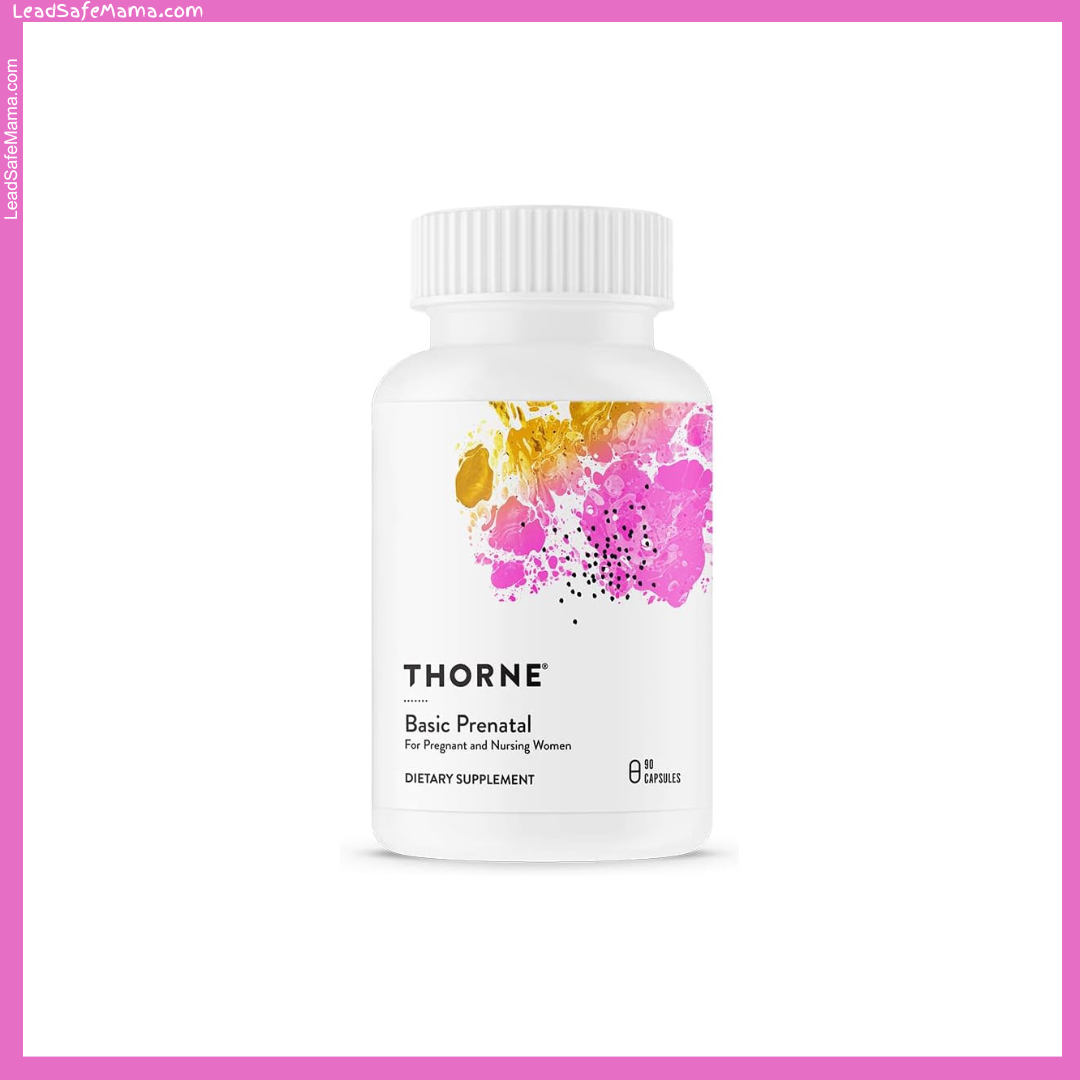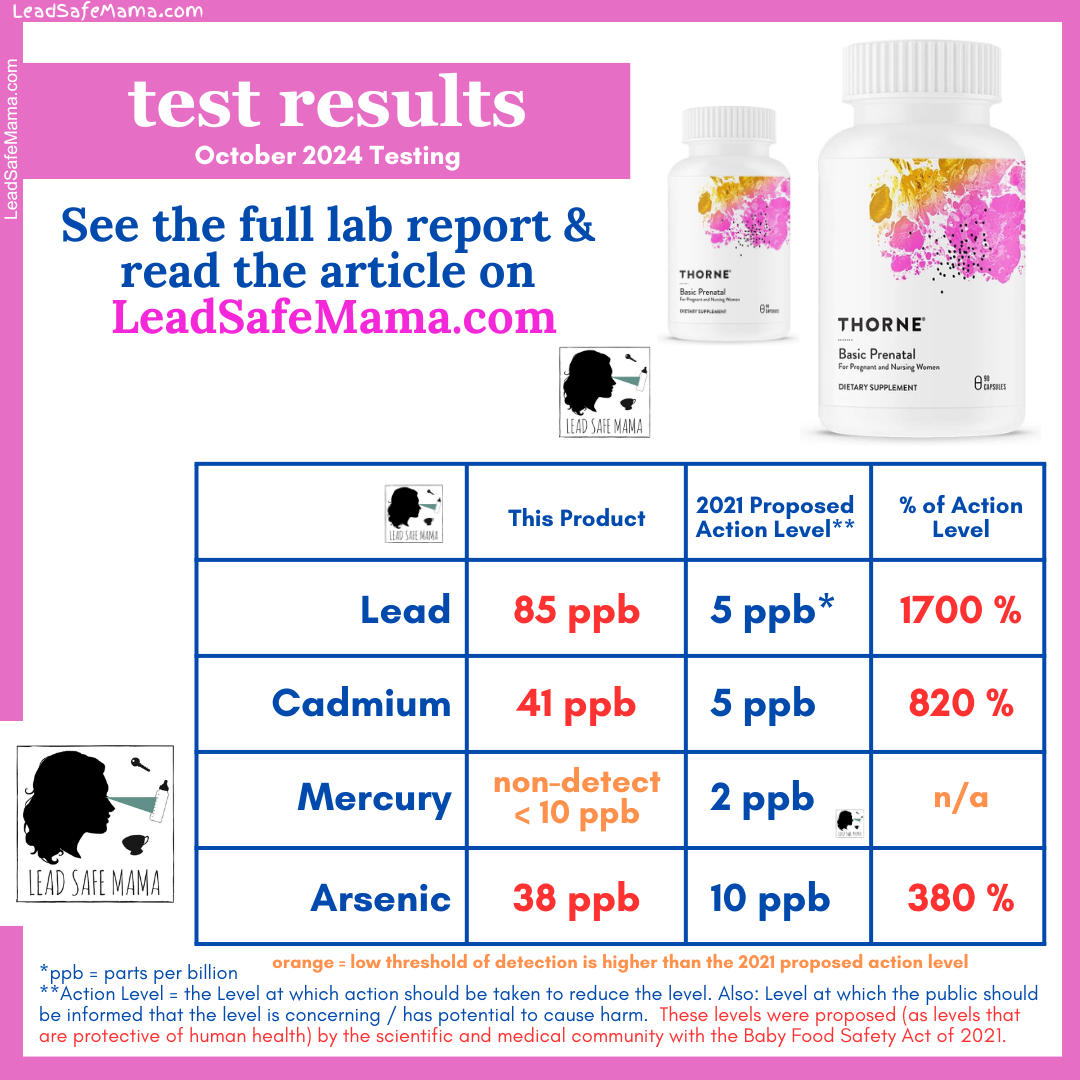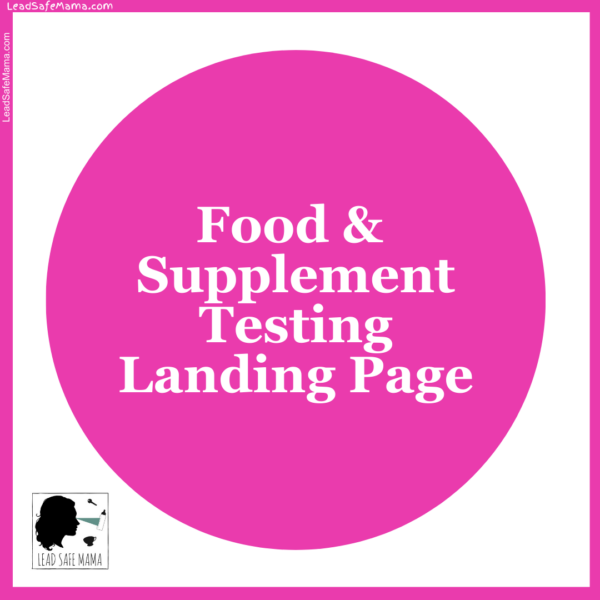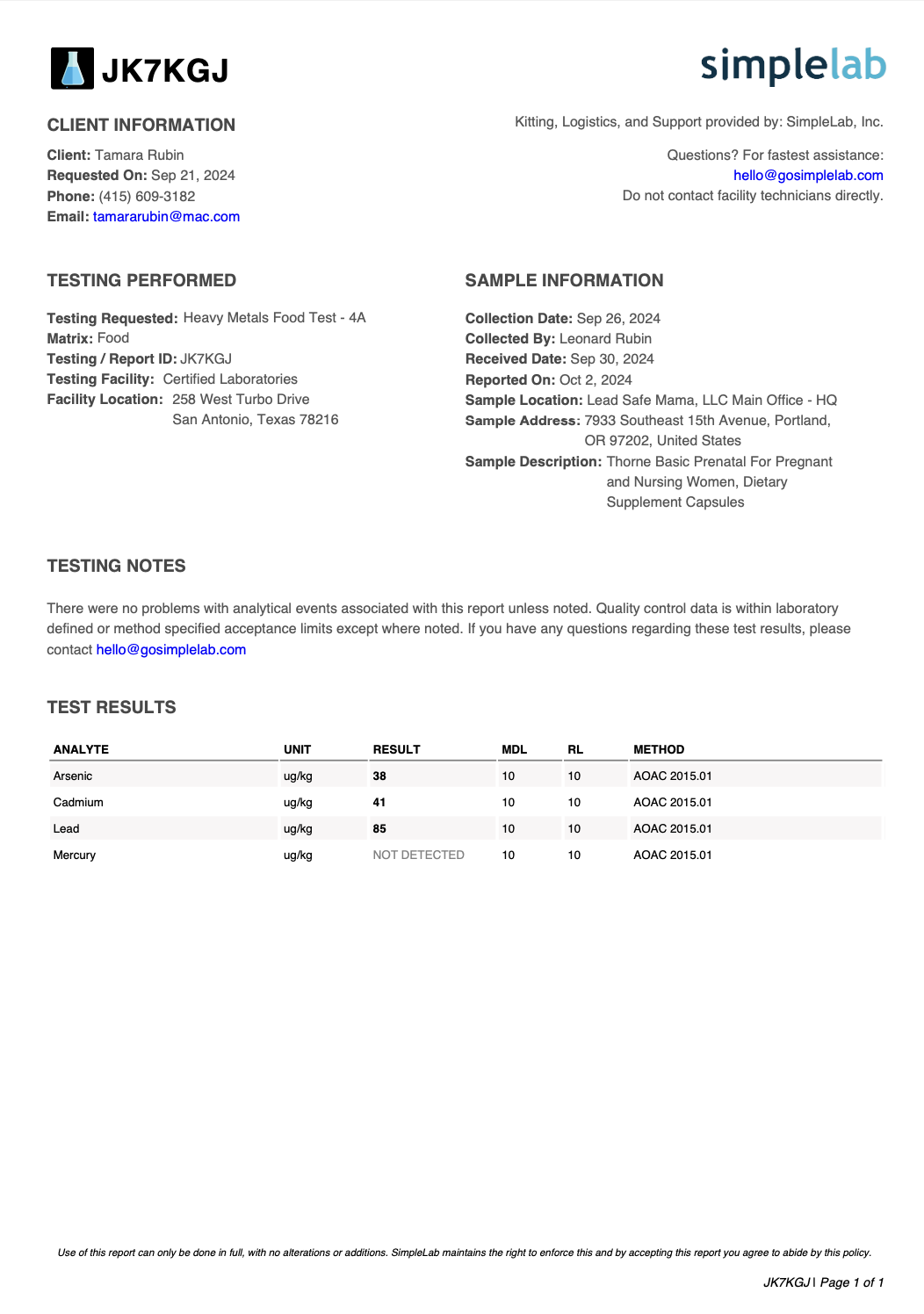Thorne Basic Prenatal Dietary Supplement For Pregnant and Nursing Women (Capsules) Tests Positive for Arsenic, Cadmium, & Lead: October 2024 Laboratory Report

Quick note from Tamara Rubin:
It is the position of Lead Safe Mama, LLC that prenatal vitamins should not test positive for Lead at levels above 2 parts per billion (ppb) (or less conservatively, definitely not at levels above 4 ppb). Prenatal vitamins should also not test positive for levels of Arsenic and Cadmium at-or-above 5 ppb.
All federal agencies agree there is no safe level of Lead exposure for humans. This is especially true for babies developing in their mother’s womb. The impact of Lead is also cumulative over one’s lifetime (starting with — and eve before — conception). Scientific research has established that even trace Lead exposure (levels far below those previously known or thought to cause harm) can cause long-term negative health impacts, including fertility complications, birth complications, and negative birth outcomes (including low birthweight in newborns). You can learn more about the concern for impacts of even trace exposure for women of childbearing age at this link.
It is for the above reasons that we hope the manufacturers learning this information about their prenatal vitamins (from the collaborative scientific inquiry the Lead Safe Mama community has coordinated — conducting independent, truly third-party laboratory testing of popular products) will take all possible actions to significantly reduce the amount of Lead in these products.
Key points to note (with the prenatal vitamin testing we are conducting):
- While there is no safe level of Lead exposure, and while the levels of Lead we are finding (across the board in prenatal vitamins) is concerning, it is important to note that IF the Lead in your prenatal vitamin were your only source of Lead exposure, it is not likely this would result in a positive blood Lead level (BLL) test.
- There are a lot of factors at play here, but the most important one is that most BLL tests for women of childbearing age are not testing down to a level of sensitivity that would detect a BLL of 0.1 or 0.2 (for example) that might be caused from daily ingestion of a Lead-contaminated vitamin.
- Most BLL tests for women of childbearing age have a low threshold of detection of 5.0 (micrograms of Lead per deciliter of blood), while some have a low threshold of detection of 1.0, 2.0, or 3.3 (depending on the testing methodology and instrumentation used).
- Dr. Rabito’s research (from 2011, published in 2012) found correlative impacts for birth, pregnancy, and fertility with BLL’s as low as 0.43 micrograms of Lead per deciliter of blood.
- We still recommend you consider asking your doctor for a Blood Lead Level test — both as a pre-conception measure and a prenatal measure, so you at least have a baseline in your medical chart (even if the low threshold of detection for the testing is too high to detect food-source exposures. You can read more about that here and here).
- We also recommend you talk to your doctor about pharmaceutical grade prenatal vitamins (if a prenatal vitamin is specifically recommended in your situation) and about the possibility of maximizing your diet to emphasize dietary sources of the vitamins and minerals most beneficial for your pregnancy.
Note / Update: To resolve some ambiguity, I wanted to share the following points:
- The proposed action levels (discussed in detail below, and shown in the summary graphic with this article) are for baby food (noted in the graphic as proposed with the BABY FOOD Safety Act of 2021).
- Given the impact of prenatal vitamins on a developing fetus, and given the vulnerability of babies in the womb in general, it is our position that the Action Levels that were proposed for Baby Food should also be used as a guidance for setting toxicant limits for prenatal vitamins.
- There is not (and has never been) a proposed action level appropriately limiting the presence of toxicants in prenatal vitamins (as a measure of total content of toxicants, measured in parts per billion, not based on serving size. This is discussed in greater detail below).
- As mentioned below – for all of the laboratory testing we are doing we are comparing the test results to the context for items that may be ingested by children.
- The following statement has been a concluding statement of this article, but for clarification we are adding it here as well:
- “As there are almost no reasonable safety thresholds proposed for toxicants (heavy metals) consumed by adults (in foods and supplements), our focus is (as always) on the health of children. The available proposed safety thresholds (and guidance) for foods and supplements consumed by adults are not set at levels protective of human health and are therefore not relevant to the work we do here at Lead Safe Mama, LLC.”
Additionally – on December 9, 2024 a new article was published in Vogue Magazine about the concern for toxicants found in prenatal vitamins. Here’s the link to the Vogue piece. Here’s the link to the study referenced in the Vogue piece. Some additional reading that may be of interest (these studies are also linked in some of our other articles about prenatal vitamins:
- 2018 Study: Heavy Metal Contamination of Prenatal Vitamins – link – “Toxic elements are found in prenatal vitamins with lead at unacceptable levels in more than half of the products tested.”
- January 2024 Summary, United States – link
- October 2023 Study – link
- 2019 News Piece – link
- To see all of the Prenatal vitamin test results from the independent 3rd party testing we have been doing, click here.
For those new to the Lead Safe Mama website:
Tamara Rubin is a multiple-federal-award-winning independent advocate for childhood Lead poisoning prevention and consumer goods safety, and a documentary filmmaker. She is also a mother of Lead-poisoned children (two of her four sons were acutely Lead-poisoned in 2005).
- Tamara owns and runs Lead Safe Mama, LLC — a unique community collaborative woman-owned small business for childhood Lead poisoning prevention and consumer goods safety.
- Since July of 2022, the work of Lead Safe Mama, LLC has been responsible for six product recalls (FDA and CPSC).
- All test results reported on this website are science-based, accurate, and replicable.
- Please check out our press page to see some of the news coverage of our work – link here.
This is an ad-free article.
Advertising and affiliate income help Lead Safe Mama, LLC cover the costs of the work we do here (independent consumer goods testing and childhood Lead poisoning prevention advocacy). We have removed ads from most of our more widely-read articles (and newly published articles, too — like this one!) to make them easier for you to read. In addition to supporting this work by starting any shopping you might be doing with a click on our affiliate links, if you would like to support the independent consumer goods testing and childhood Lead poisoning prevention advocacy work of Lead Safe Mama, LLC by making a contribution (which will also help us keep our more widely-read articles ad-free), click here. Thank you!
Important Background: What is an Action Level?
Please note the following key points:
The original lab report for this product is below (at the bottom of this page).
The graphic above shows the levels of metals detected in this product (in red) along with the low threshold of detection (in orange, above the action levels discussed/ or in green, below the action levels discussed) for each metal not detected with the laboratory testing Lead Safe Mama, LLC had completed for this product. The numbers are juxtaposed (in blue) to the “Action Level” for Baby Food proposed by the medical and scientific community in 2021 as part of the Baby Food Safety Act.
- These 2021 levels were proposed as “Action Levels” for baby food because they are (in fact) protective of human health.
- An “Action Level” is NOT the same as a “Maximum Allowable Level.”
- Many food manufacturers misinterpret guidance on heavy metals to mean “allowable levels” and consider it reasonable for products to test positive below these levels.
- This is a (perhaps intentional?) misunderstanding/ misinterpretation the food industry makes — a misunderstanding that food manufacturers use to justify the presence of heavy metals in products.
- Heavy metals accumulate in the body.
- It is the cumulative/ aggregate impact of heavy metal exposure (over a lifetime) that makes even small/ incidental/ seemingly trivial exposures particularly damaging and dangerous. You can read more about that here.
- Once a food product has the amount of heavy metal (Lead, Cadmium, Mercury, or Arsenic) noted (above) as the “Action Level,” that product is officially considered (by the scientific and medical community) unsafe for consumption by children as toxicants (found at-or-above these levels) are in the range of heavy metal levels that have been demonstrated to cause lasting harm.
- Action Levels are unrelated to serving size.
- Action Levels are relevant for any amount of a food product that may be consumed (any quantity of the food in question).
- PPB (parts per billion/ ppb) measurements are a percentage (albeit a very small percentage) and apply to any quantity of the food product tested.
- For more discussion about serving size considerations (and why relying on “serving size” to limit toxicant exposure is not a relevant metric/ not a metric protective of human health), read this article.
- These “Action Levels” proposed in 2021 are the levels at which the scientific and medical community believe the manufacturer (or government) needs to take ACTION to fix the problem.
- One “Action” would be for the manufacturer to take steps to reduce the levels of toxicants in the food product.
- Another “Action” would be for the manufacturer to cease sales of the product until the product could be made safe.
- Another “Action” would be for the manufacturer to inform the public that a specific food product has an unsafe level of the metal detected at-or-above the “Action Level” — making a highly-visible public announcement regarding which relevant batches of the product should be recalled/ no longer consumed.
- The Action Levels proposed with the Baby Food Safety Act of 2021 were not arbitrary toxicant levels, but were proposed because they are the levels most protective of human health. However, the Baby Food Safety Act of 2021 was not passed into law.
- Regardless of the fact the Baby Food Safety Act of 2021 never passed into law — and it is therefore legal to have foods and supplements marketed for consumption by children test positive for Lead, Cadmium, Mercury, and Arsenic at-or-above these levels — these Action Levels still reflect the current (modern/ relevant) advice of the medical and scientific communities as levels both achievable by the industry and safeguards of infant and toddler health.
- Food and supplement industry lobbyists fought against formalizing these proposed “Action Levels” as a government standard, alleging the levels were unachievable.
- The list of safer choices (below) clearly demonstrate these Action Levels as achievable across a range of food types (salt, flour, coffee, oatmeal, chia seeds, hemp seeds, soy milk, packaged fruit-based snacks, beverages, and more).
- The legitimacy of these levels as “Action Levels”/ “Levels of Concern” (even though they were not adopted as law) is mirrored by the legitimacy of the American Academy of Pediatrics’ level of concern for Lead in water, which is 1 ppb despite the FDA’s official “level of concern” for Lead in water being 15 ppb (you can read more about that here).
“Simply Not Achievable”
To reiterate: While the packaged, processed food industry would have consumers (and the government) believe the standards proposed in 2021 are unachievable, this industry position (an oft-rearticulated response to nearly every set of laboratory test results for food and supplements that we have published to date) is simply not true.
It is possible to make safer processed, packaged food products and supplements that fall well below the safety limits for toxicants proposed within the Baby Food Safety Act of 2021. To wit, the products listed below (the first section of the list below) tested “non-detect” for Lead, Cadmium, Mercury, and Arsenic — several even tested non-detect for Lead with the low threshold of detection being “less than 1.5 ppb.”
Below is an EXPANDING list of products (foods and supplements) that have tested “non-detect” for Lead, Mercury, Cadmium, and Arsenic with independent, third-party, crowd-funded laboratory testing coordinated by Lead Safe Mama, LLC (an Oregon-based small business with a unique community-collaborative business model and a focus on consumer goods safety and childhood Lead poisoning prevention).
–
The limits of detection for each of the metals tested are noted in the lab report for the specific product listed. To see the full lab report for any of these products, type the brand name into the search bar at the top of any page on Lead Safe Mama dot com (and scroll down to the bottom of the related article).
–
Flavors tested are noted, and other flavors of the same product (or other products from the same brand) have either not been tested or have been tested but did not yield similar results. Test results only apply to the specific products linked below.
LIST UPDATED November 26, 2024:
- Beverage — Olipop Grape Tonic: https://amzn.to/4cjFYZu
- Breakfast Item — 1 — Nature’s Path Envirokidz Organic Panda Puffs: https://amzn.to/4fo1crf
- Breakfast Item — 2 — One Degree Organic, Gluten-Free, Sprouted Rolled Oats (Canada): https://amzn.to/3WIQ1BN
- Candy — Cavendish & Harvey Wild Berry Drops, not Organic (Germany): https://amzn.to/3Z1Jxjr
- Coffee — 1 — Chameleon Handcrafted Organic Cold Brew Concentrate: https://amzn.to/3OcrH77
- Coffee — 2 — Death Wish Organic Espresso Roast Ground Coffee (Multi-country Origin, non-USA): https://amzn.to/3yo1eiL
- Plant-Based Coffee Creamer — 1 — Laird Superfood Coconut Creamer: https://amzn.to/4fItA7A
- Dairy Coffee Creamer — 2 — Organic Valley Grassmilk Half and Half: https://amzn.to/4fHJIWT
- Fruit Snack — 1 — GoGo Squeez Organic Apple Sauce Pouch: https://amzn.to/3XhWYLe
- Fruit Snack — 2 — Pure Organic Layered Fruit Bars in Strawberry Banana Flavor: https://amzn.to/3WQEekA
- Fruit Snack — 3 — Once Upon A Farm Dairy Free Fruit Smoothie Pouch in Strawberry Banana Swirl Flavor: https://amzn.to/3CPMbAw
- Fruit Snack — 4 — Pure Organic Layered Fruit Bars in Raspberry Lemonade Flavor: https://amzn.to/3XcFsIp
- Infant Formula — 1 — Bobbie Organic Gentle Infant Formula Milk-Based Powder with Iron: https://amzn.to/3YYb849
- Infant Formula — 2 — Bobbie Grass-Fed Milk-Based Powder with Iron: https://amzn.to/3ZlAaeJ
- Infant Formula — 3 — ByHeart Infant Formula (USA-Made, not organic): https://amzn.to/48DJjTb
- Infant Formula — 4 — HiPP Bio Combiotik Infant Formula Powder – Stage 1 (imported)
- Infant Formula — 5 — Holle Bio Goat Stage 2 Infant Formula (for 6-10 months, organic, European — Swiss/ German/ Austrian) is not available on Amazon, but the Stage 3 version of this product is (not yet tested, but will likely test similarly): https://amzn.to/3BVU7zI
- Infant Formula — 6 — Kendamil Goat Infant Formula (not organic): This product may be available at Target (it is not available on Amazon)
- Infant Formula — 7 — Kendamil Organic Follow-On Milk (European/ British Toddler Formula, for 6-12 months, Cow Milk): Not available on Amazon (report link)
- Infant Formula — 8 — Kendamil Organic Infant Formula (Cow Milk): Not available on Amazon but may be available at Target
- Ingredient — 1 (salt) — Jacobsen’s Sea Salt (Oregon, USA): https://amzn.to/4dcbk5L
- Ingredient — 2 (baking flour) — Jovial Organic Einkorn Flour (Italy): https://amzn.to/3LIqxix
- Ingredient — 3 (seeds) — Costco Kirkland Organic Hemp Seeds: https://amzn.to/4e05RP9
- Ingredient — 4 (seeds) — Navitas Organic, Gluten-Free Chia Seeds (Mexico): https://amzn.to/3YvE7xC
- Oil — 1 — Chosen Foods 100% Avocado Oil (not organic): https://amzn.to/3YDZSuv
- Oil — 2 — Dr. Adorable’s Organic Perilla Seed Oil (Korea): https://amzn.to/3NDt7Yc
- Plant-Based Milk — 1 — Kiki Milk Organic Plant Based Milk (original flavor): https://amzn.to/3AA6Qrt
- Plant-Based Milk — 2 — West Soy Unflavored Unsweetened Organic Soy Milk: https://amzn.to/4dwev8l
- Supplement — 1 — Nordic Naturals Omega-3 Fish Oil: https://amzn.to/48q1j2V
- Supplement — 2 — Mary Ruth’s Organic Toddler Multivitamin Liquid Drops with Iron: https://amzn.to/3YPhcgx
Stand by for more!
–
BONUS FOUR: Below are FOUR additional products that each tested positive for trace (very low levels of) Arsenic — at levels considered safe by all standards (with the limits of detection noted in the lab report for the specific product listed):
- Infant Formula — Kendamil Goat Toddler Milk, not Organic (positive for traces of Arsenic): May be available at Target or through other online retailers of European infant formulas
- Fruit Snack — That’s It Apple Cherry Bars, not Organic (positive for traces of Arsenic): https://amzn.to/4fHkSWV
- Oil — Chosen Foods 100% Pure Avocado Oil — Organic (postive for traces of Arsenic): https://amzn.to/3BVQYQa
- Supplement — Now Sunflower Lecithin, not Organic (positive for traces of Arsenic): https://amzn.to/3AFdHzO
Amazon links are affiliate links.
Published: October 27, 2024
Sunday
Hello! We are working on publishing a LOT of test results very quickly this month.
We will be updating this section of each article (with more information about the specific product and other similar products for context) as time permits, but we wanted to ensure the greater Lead Safe Mama community (and the general public) had access to this scientific data (about foods and supplements in their home) as quickly as possible.
Please scroll down to see the full laboratory test report for the product pictured above. Thank you for your patience.
As there are almost no reasonable safety thresholds proposed for toxicants (heavy metals) consumed by adults (in foods and supplements), our focus is (as always) on the health of children. The available proposed safety thresholds (and guidance) for foods consumed by adults are not set at levels protective of human health and are therefore not relevant to the work we do here at Lead Safe Mama, LLC.
This is the Lead Safe Mama Amazon affiliate link to purchase a test kit similar to what we use for our laboratory testing.
To see more articles related to the laboratory testing for foods and supplements Lead Safe Mama, LLC is organizing (including background on this initiative and safer food choices and guidelines), click the pink square below. To see the full, independent, third-party, laboratory report for the product pictured above, please scroll down to the bottom of this page.
Amazon links are affiliate links. If you purchase something after clicking on a Lead Safe Mama, LLC Amazon affiliate link, Lead Safe Mama, LLC may receive a percentage of what you spend — at no extra cost to you.
Lab report for the product pictured above:
Never Miss an Important Article Again!
Join our Email List










lot?
This is really concerning for Thorne, especially since they’re considered one of the more reputable brands in the supplement industry. I’ve reached out to them several times for heavy metal reports but never received a response—now it seems clear why!
As a follow up, could you please test THORNE Basic Nutrients 2/Day – Comprehensive Daily Multivitamin with Optimal Bioavailability, the more popular and widely used supplement? Thank you.
Hey Lead Mama!
I wrote into Thorne about your finding and here is their response.
Thoughts???
Thank you for reaching out about our Basic Prenatal. We really appreciate your outreach and diligence in seeking clarification on our nutritional supplements.
As required by federal regulation, Thorne tests every lot of raw material that it receives to verify the raw material’s identity, purity, and potency. This includes testing the raw material for the presence of suspected contaminants that would be relevant to that raw material, which for every material includes testing for the presence of heavy metals.
Heavy metals standards are based on the upper amount of a heavy metal that is deemed safe to ingest on a daily basis. Every Thorne product meets or is below the heavy metal standards designated by the United States Pharmacopeia (USP). The USP has well-accepted and well-recognized heavy metal exposure standards for medicines, food ingredients, and nutritional supplements, and Thorne has complied with the USP’s heavy metal exposure standards for nutritional supplements for more than 30 years. The USP is an independent, scientific, non-profit organization that sets quality standards for medicines, dietary supplements, and food ingredients in the United States and many other countries.
In addition to the standards set by USP, Thorne also observes the more conservative limits as set by California’s Proposition 65 law, which advises California residents about substances believed to cause harm, such as birth defects. If a daily serving of a nutritional supplement product sold in California exceeds the minimum amount of one of the 800+ Proposition 65-listed substances, then the product label must include a warning notice. The heavy metal content in Thorne’s Basic Prenatal is below the very stringent heavy metal standards set forth in Proposition 65 and does not require a warning notice.
Regarding the results of the test conducted by SimpleLab, Inc and published by Tamara Rubin, the results presented are far below the standards set by both USP and California’s Proposition 65 law.
Heavy metal Results (ppb) Equivalent heavy metal content per day (mcg/day) Prop65 Limit
(mcg/day) USP Limit
(mcg/day)
Pb – Lead 85 0.23 ≤0.5 ≤5
Cd – Cadmium 41 0.11 ≤4.1 ≤5
Hg – Mercury ND ND ≤0.3 ≤2
As – Arsenic 38 0.10 ≤10 ≤15
Thorne appreciates every consumer’s diligence in being educated about and seeking the highest quality nutritional supplement products available to support health and wellbeing, and Thorne looks forward to continuing to provide consumers with the highest quality nutritional supplement products available to achieve their health goals.
Additionally, here is a link to a blog with additional information: https://www.thorne.com/take-5-daily/article/prenatal-vitamins-and-lead-what-a-woman-needs-to-know
Tamara what do you think of this response from Thorne?
That Thorne answer is not making me feel confident about their products at all.
Agree, sounds like an AI response
Thank you SO much for sharing this !!! I have been so very confused about what the permitted levels for Prop 65 and USP mean and how to correlate them to PPB since they are in micrograms per day, etc., so Thorne‘s response was extremely helpful to illustrate that basically prop 65 and USP are not nearly stringent enough standards to go by. (So if something does have a prop 65 warning, it must be off the charts toxic. !!!) I would LOVE a similar explanation of NSF, as many supplements claim their high standards based on NSF certification for purity (like Pure Encaspulations), and I have yet to find anything stating what those NSF standards actually are!!
Do you have prenatal recommendations that don’t test positive?
Nope
What are we supposed to take then? Just fear monger then don’t offer a solution….
I think you have our work confused with the work of someone else.
We are not fear mongering.
We are providing you with unbiased science to help you make informed decisions for yourself and your family.
It is not our job to refer you to a solution if there is no solution, although we will list safer choices when we find them.
We have not found a lead-free prenatal.
We recommend you talk to your doctor to find out if you actually need a prenatal (find out which nutritional supports you are deficient in). We also encourage diet-focused efforts for making sure you have a complete nutrient profile during pregnancy.
We encourage people never to be afraid of science. We would never recommend an unsafe product. There is no safe level of Lead exposure and we would therefore never recommend a product that tests positive for Lead.
Here’s a link to a chart with most of the prenatal vitamins we have tested:
https://tamararubin.com/2024/12/prenatal-vitamin-chart/
Here is a link to our website menu – there are several useful buttons pinned near the top of the website menu:
https://tamararubin.com/website-menu/
This is a link to all of the lab-tested safer choices we have found so far (the updated version of this list is always pinned at the top of the website menu, so you may want to check back there periodically):
https://tamararubin.com/2025/02/50/
Here’s a list of all of the lab testing we have done (this is another good page to bookmark and check back on periodically):
https://tamararubin.com/2024/05/food-articles/
If you would like to help us fund the testing and reporting of more prenatal vitamins (in an effort to find one that tests “non-detect” for Lead) – here’s our GoFundMe link which has all of our open campaigns to help cover the costs of testing and reporting for prenatal vitamins:
https://www.gofundme.com/s?q=tamara+rubin+prenatal&location-description=Portland%2C+OR&location-lat=45.520247&location-lng=-122.674195&c=342
More on the question of “fear mongering” here:
https://tamararubin.com/2020/05/i-dont-do-what-i-do-to-spread-fear-i-do-what-i-do-to-educate-so-you-can-make-informed-choices-for-your-family/
Thank you! I do appreciate the response and the work that you do- I did see the safely tested lists but still, it’s very dismal to not have any prenatals specifically that are safe:(
Have you tested Thorne Calcium-Magnesium Malate? Me and my son use these daily to sleep
No – here’s how to nominate a product:
https://tamararubin.com/nominate/
Tamara
Why have I been dropped from your mailing list and not allowed to join again.
We never drop anyone from the mail list, perhaps you unintentionally unsubscribed? Once you unsubscribe we cannot add you back with the same email address.
T
This is still very confusing since your lab results are in ppb, but the levels that you reference are in total dose per day. An amount of 85 parts per billion, but the dose is only 1000, puts it into a very different context.
There is no safe level of Lead exposure.